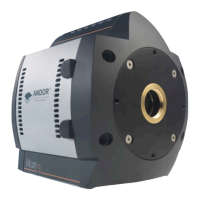Page 29
Features & Functionality
3.3.2 - Variable Horizontal Readout Rate
The Horizontal Readout Rate denes the rate at which pixels are read from the shift register. The faster the horizontal
readout rate the higher the frame rate that can be achieved. The ability to change the pixel readout speed is important
toachievethemaximumexibilityofcameraoperation,particularlyintermsofdynamicrange.Slowerreadouttypically
allows lower read noise and higher available dynamic range, but at the expense of slower frame rates. There are number
of different horizontal readout rates available on all iXon3 models. Please refer to the performance sheet for readout rates
available on your particular model.
3.3.3 - Variable Vertical Shift Speed
The vertical shift speed is the time taken to vertically shift all pixels one row down, with the bottom row entering the
shift register. The ability to vary the vertical shift speed is important for several reasons. It is possible using the different
vertical speeds to better synchronize the frame rates to external events such as a confocal spinning disc. Faster vertical
shift speeds also have benets such as lower Clock Induced Charge (CIC). A drawback with faster vertical shift speeds
is that the charge transfer efciency is reduced, effectively reducing the pixel well depth. This is particularly important for
bright signals as a pixel with a large signal is likely to have some charge left behind if the vertical shift speed is too fast.
This will result in degraded spatial resolution.
Slower vertical clocks ensure better charge transfer efciency giving maximum pixel well depth but result in a slower
maximum frame rate. To improve the transfer efciency the clocking voltage can be increased using the vertical clock
voltage amplitude setting. However, the higher the voltage, the higher the clock-induced charge. Thus the user must
make a measured judgement as to which setting works best for their situation, for example:
• For low CIC: Use the fastest vertical shift speed that still transfers charge correctly (no image distortion),
without having to select excess vertical shift voltage amplitude
• For maximum pixel well depth: Use the slowest vertical shift speed, which will give an increase in CIC
• For maximum frame rate: Use the fastest vertical shift speed and increase the vertical shift voltage amplitude
to the minimum value that regains the full pixel well depth.
• To reduce vertical smearing during very short exposure: use a faster vertical shift speed. This vertical
smearing is due to the fact that light is still falling on the image area during the short time taken to transfer the
charge from the image area into the storage area. If the actual exposure time is of a similar magnitude to this
transfertimethenaspixelsareshiftedverticallythroughbrighterregionsoftheimagetheywillcollect“extra”
charge which will manifest itself as vertical streaking. NOTE: For extremely short exposure times, a fast
external shutter or pulsed light source may be required.
• For short exposures (e.g. 1ms): with high signal count and DC illumination, it may be necessary to increase
the vertical clock voltage to ensure that the keep clean cycle can fully remove the extremely high (saturated)
signal that may have accumulated during the sensor readout phase.

